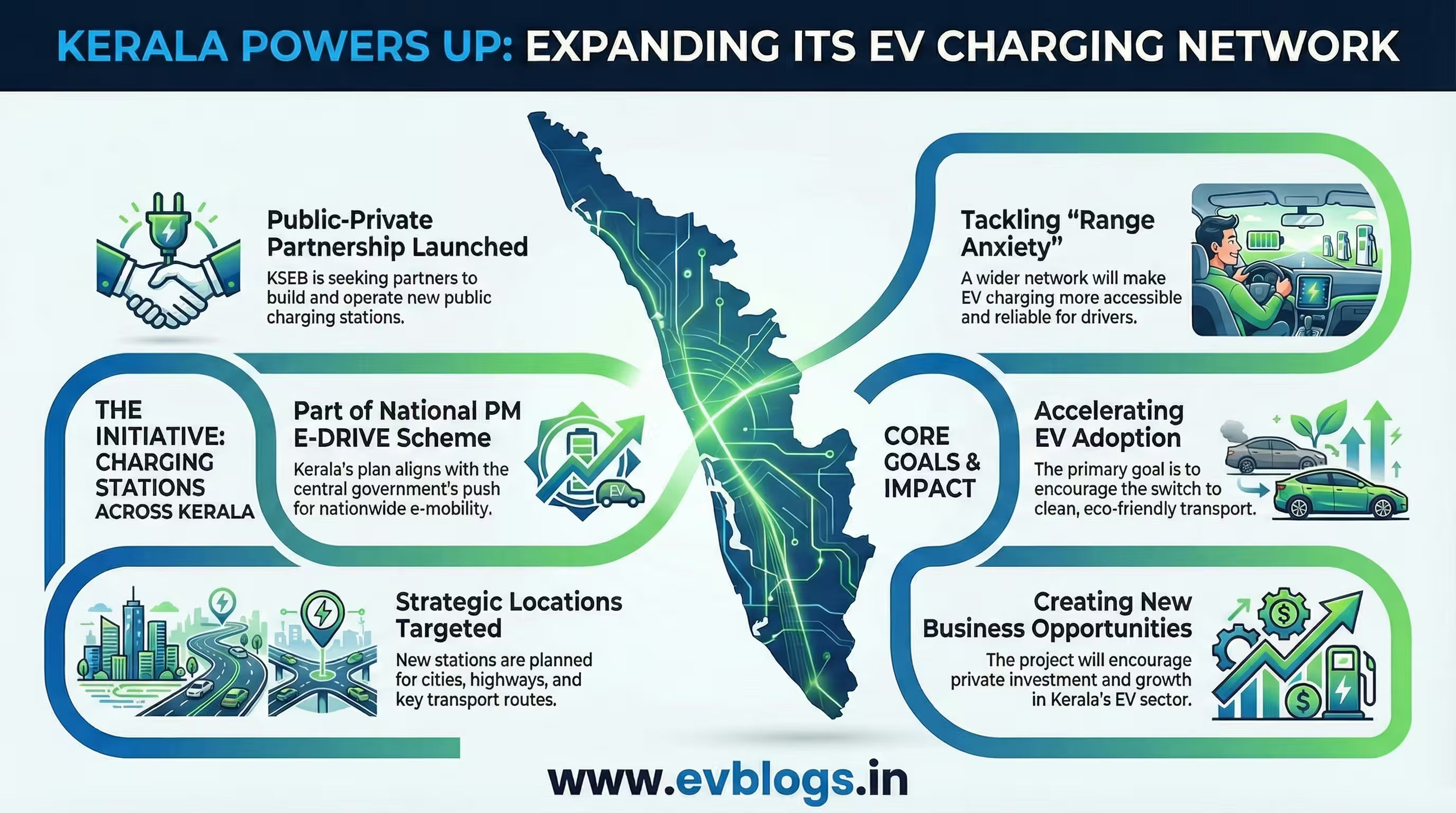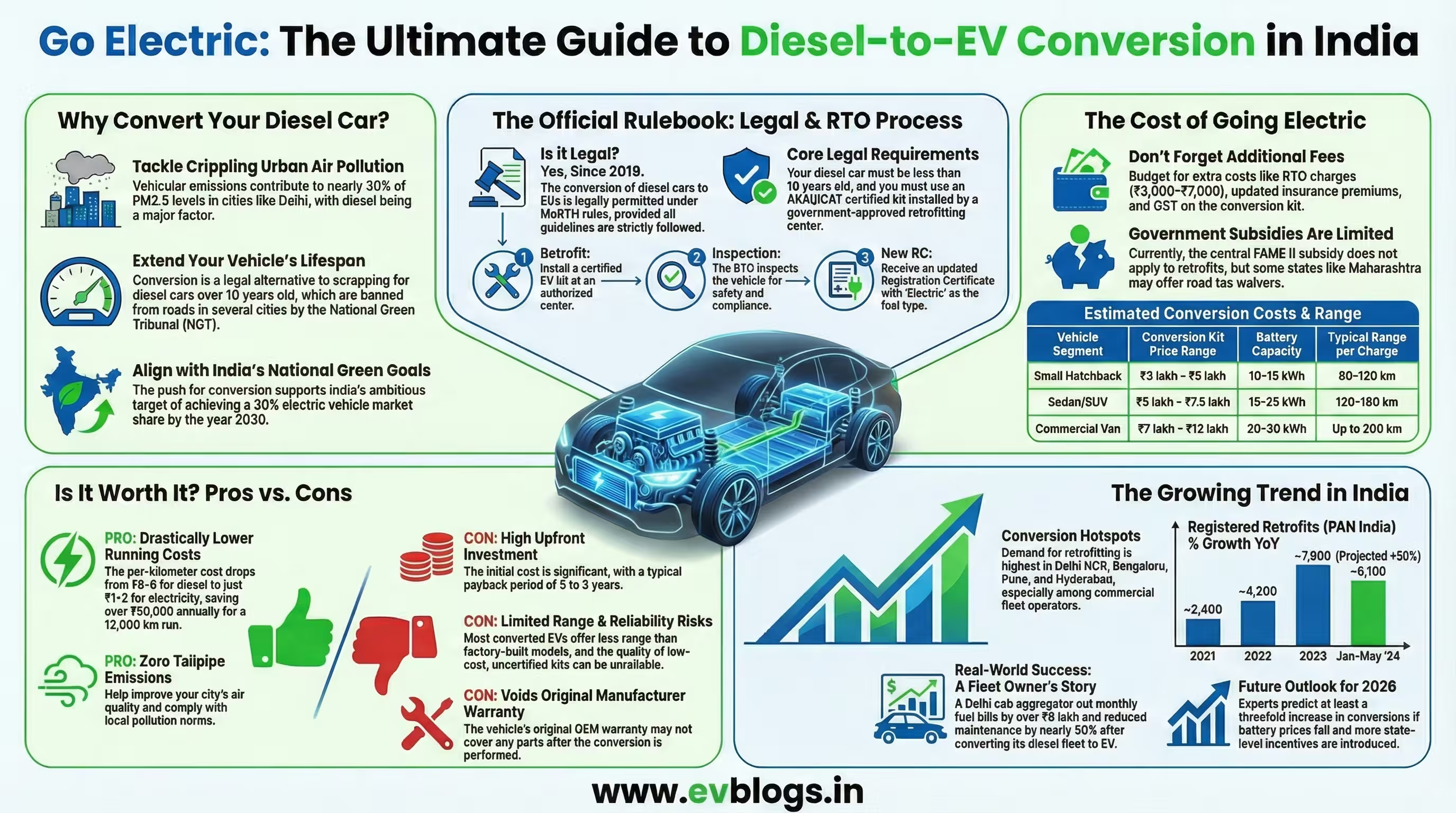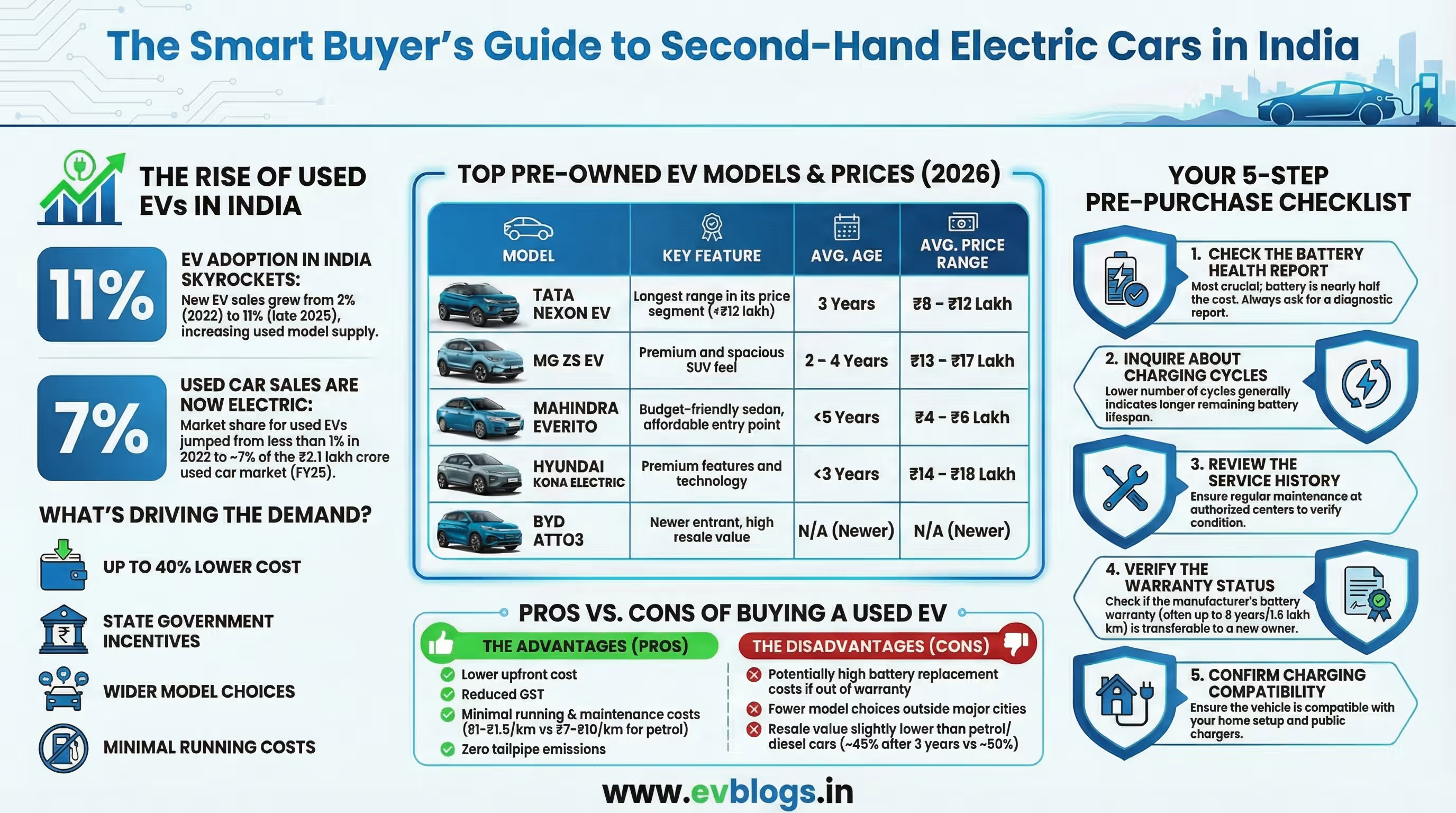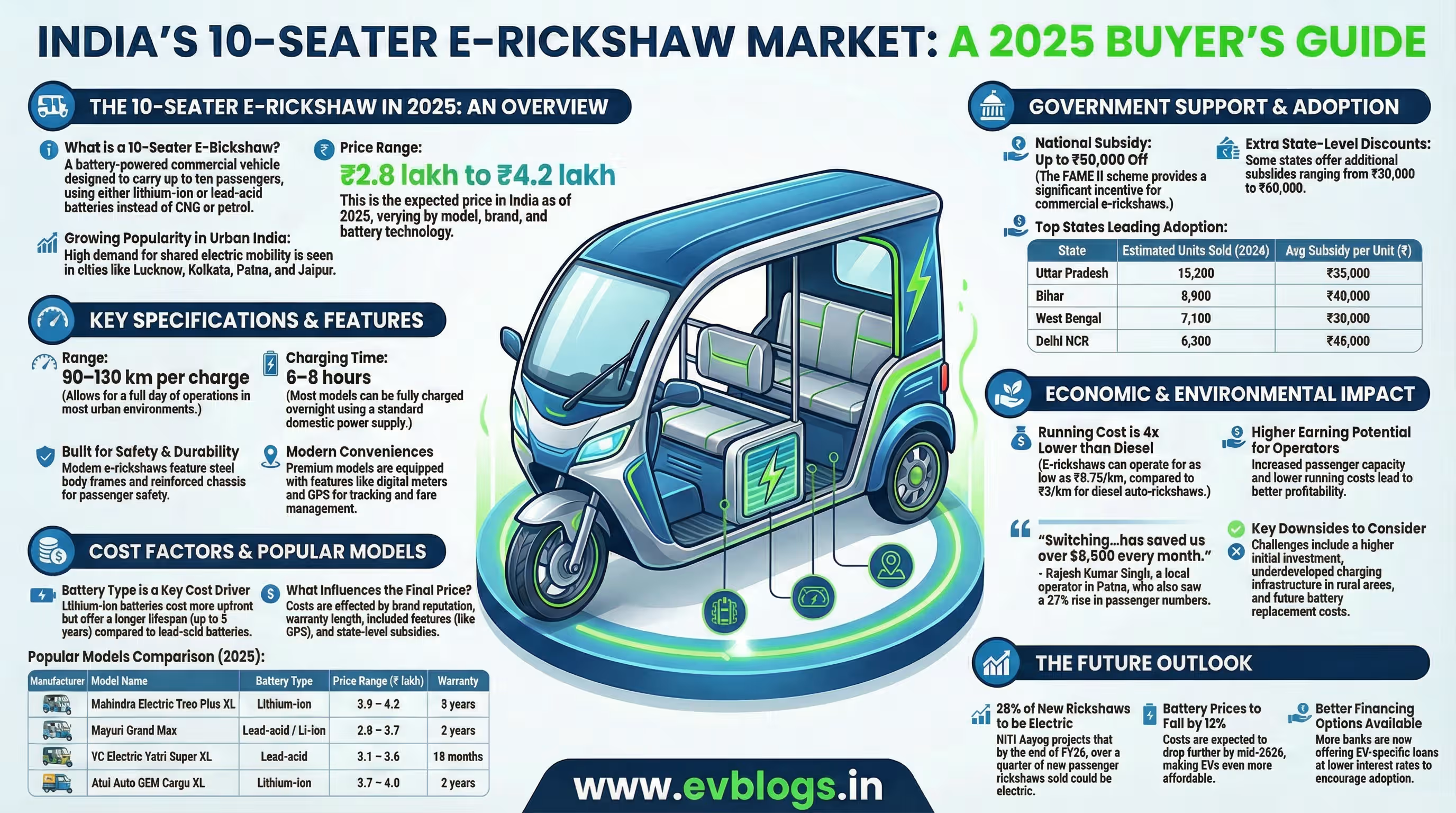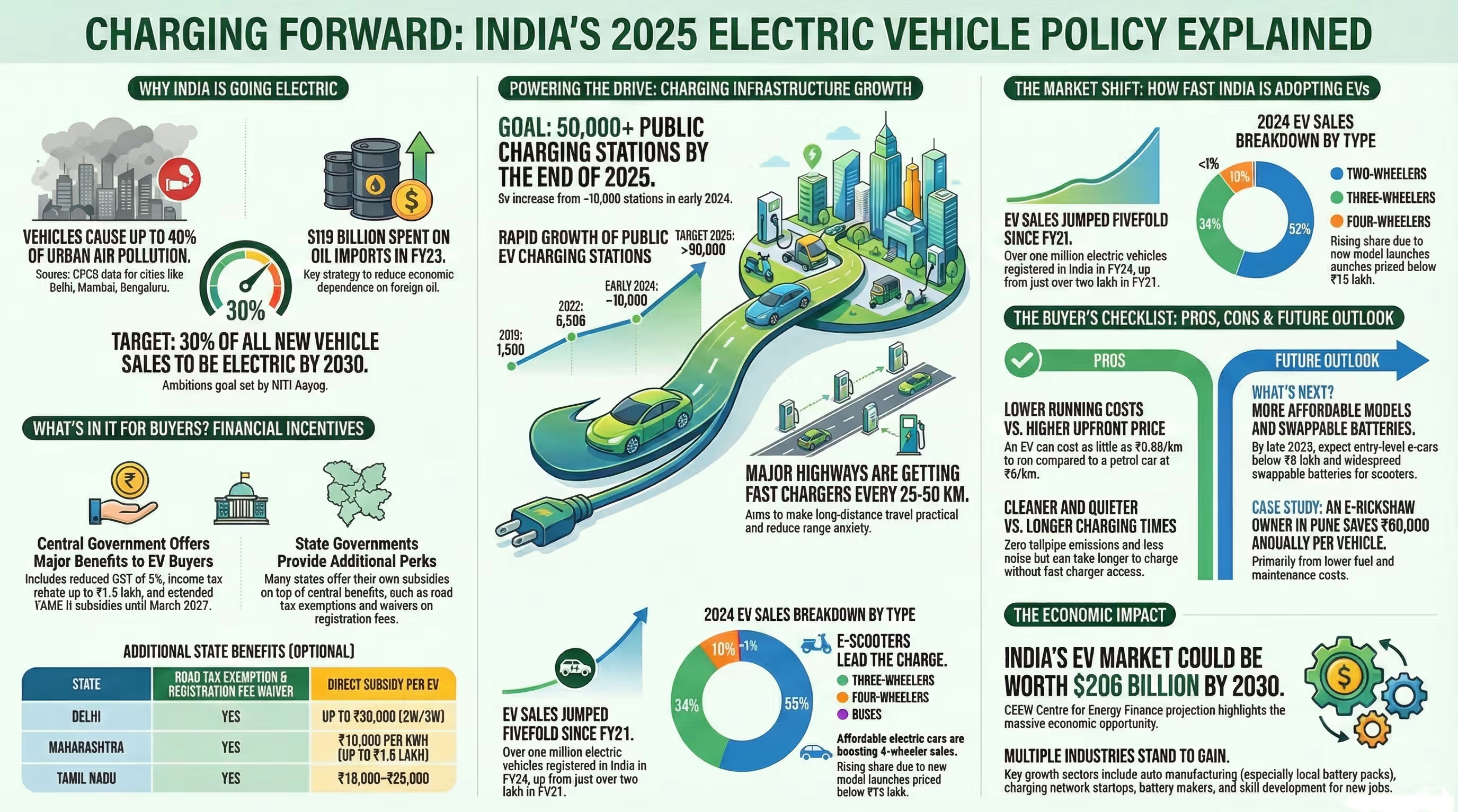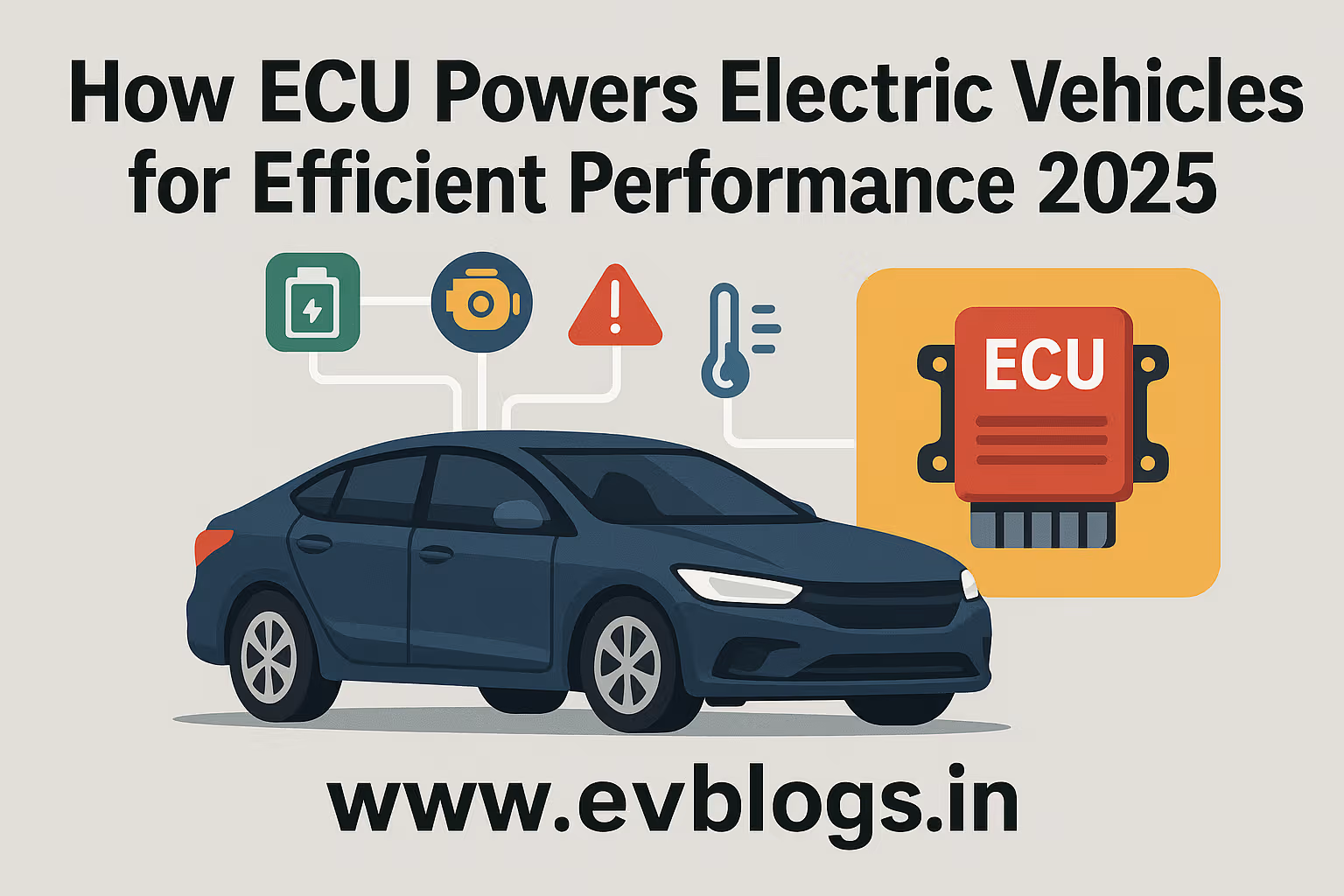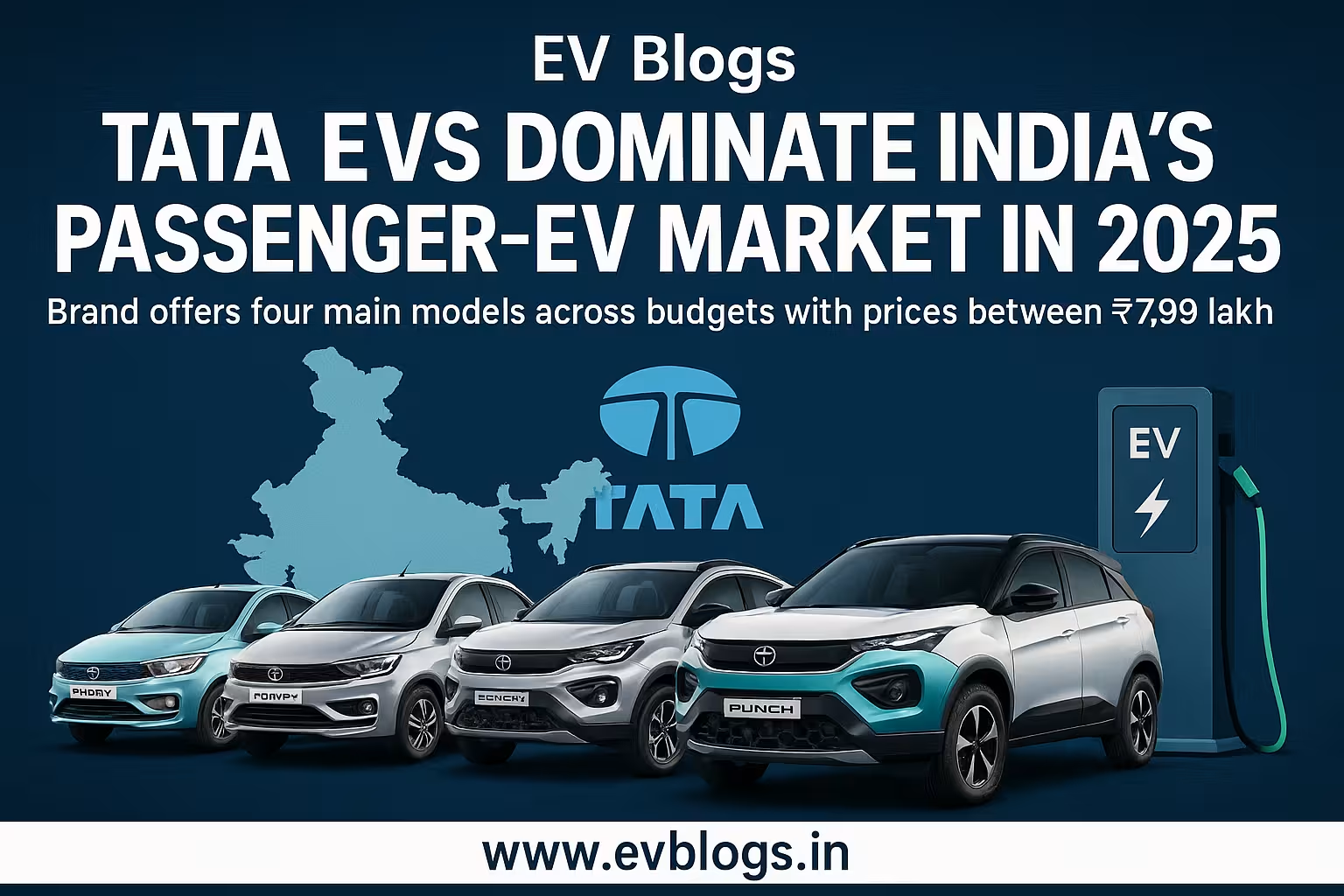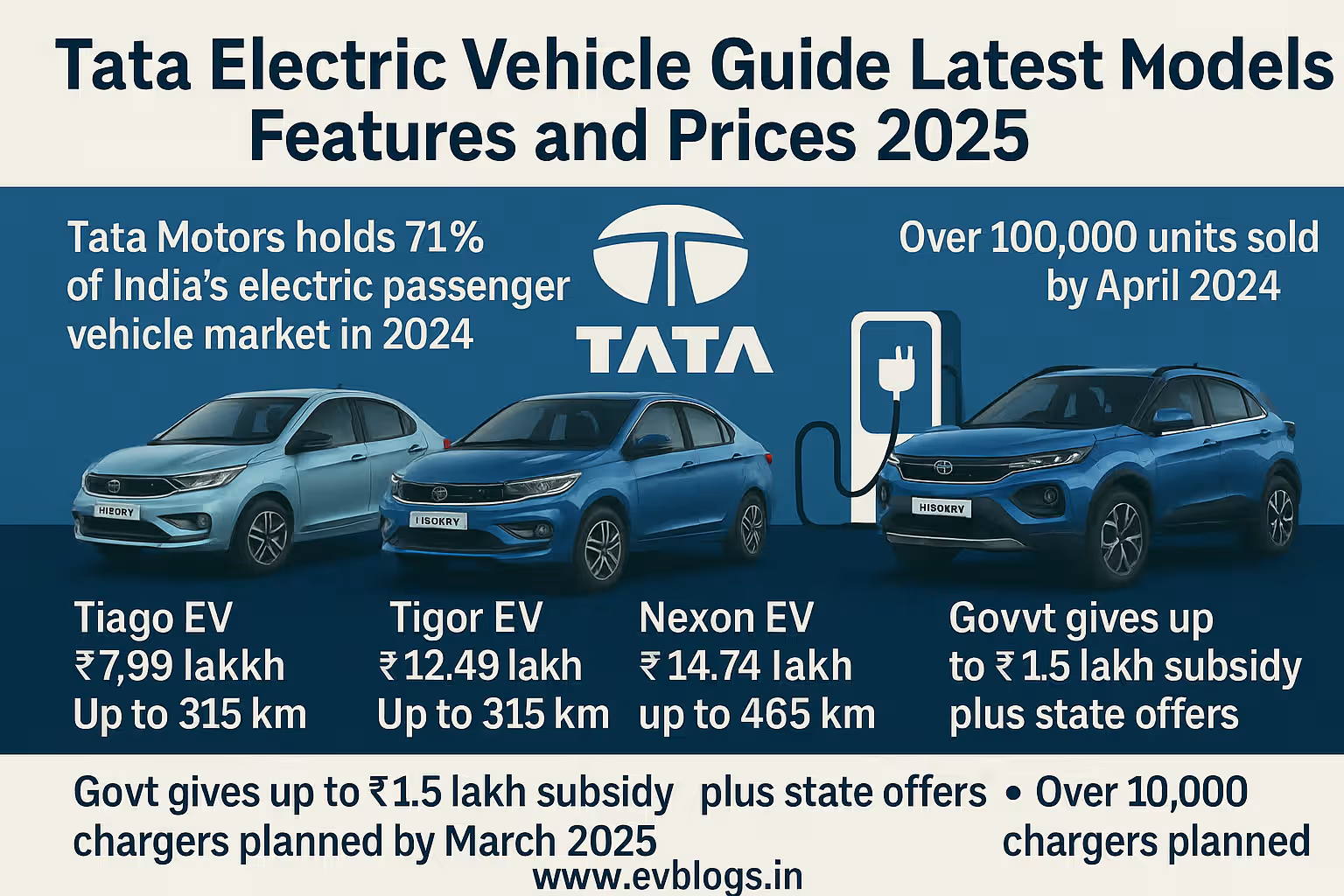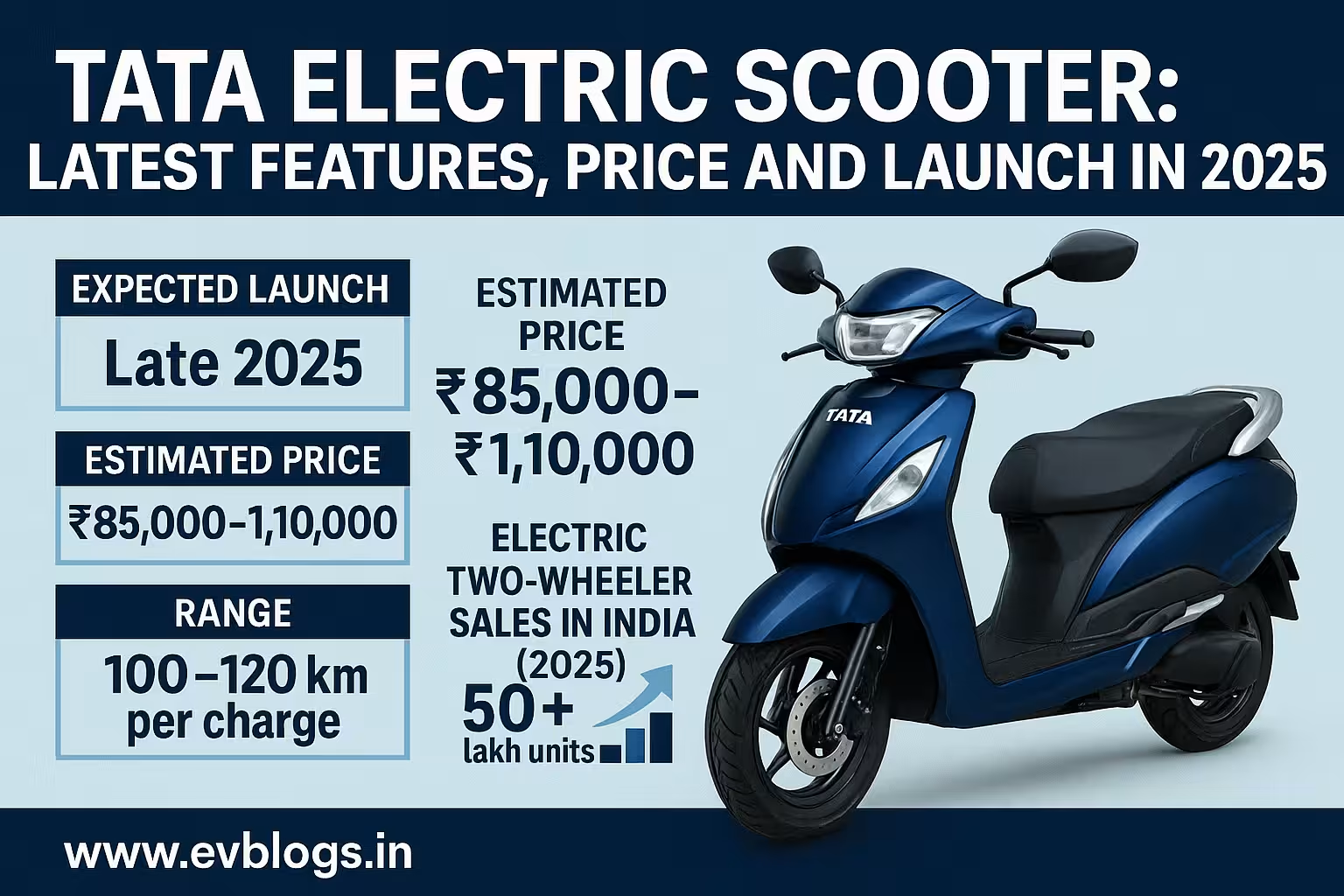Hedhvick Hirav
Hedhvick Hirav is a dedicated EV researcher and editor with over 4 years of experience in India’s growing electric vehicle ecosystem. Their contributions have been recognized in leading sustainability publications and automotive journals.
Summarize & analyze this article with
Choose an AI assistant and open this article directly:
Tip: if the AI doesn’t fetch the page automatically, paste the article URL manually.
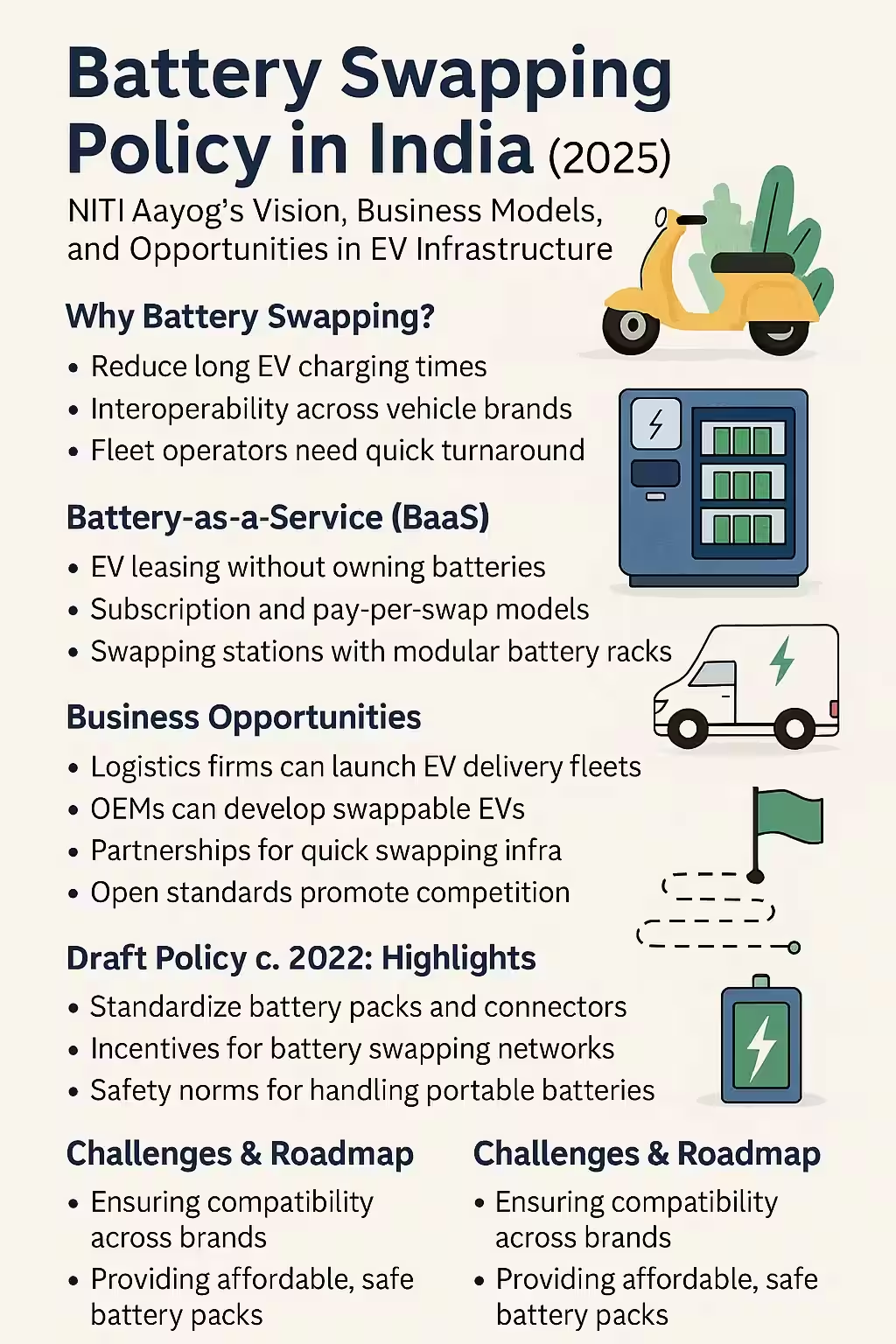
Battery Swapping Policy in India 2025: A detailed Guide
Introduction: Battery Swapping Revolution is needed
Advancing mobility to a green state with India is at a critical point. By 2025, electric vehicles (EVs)—especially two- and three-wheelers—are no longer just a futuristic vision but an everyday reality on the roads of major cities and even smaller towns. However, there is one problem that is still to be solved battery-charging infrastructure.
The high charging times, fewer charging outlets and the initial cost of EV batteries have frequently deterred the individual and the fleet operators to switch to electric. The Government of India, in its turn, came up with the Battery Swapping Policy that would help unlock even faster adoption and render EV more accessible, practical, and affordable to everyone.
The article will give you an in-depth, people-first insider view of what Battery Swapping Policy in India is like in 2025, how it works, its performance in the interests of many, who can become the beneficiary, the eligibility requirements, the estimates alongside the opinion of the experts, and the practical guidance as well as the answers to your most burning questions.
What is Battery Swapping Policy?
What is the meaning of Battery Swapping?
Battery swapping enables EV users to swap empty batteries with fully charged ones at any allocated battery swapping points. Unlike conventional charging—which can take anywhere from 30 minutes (fast charging) to several hours—battery swapping can be completed in just a few minutes.
Genesis and development of a policy
- Draft Stage: The ministry of power was the first disclosure to issue a guideline on battery swapping in April 2022.
- 2025 Update: The policy has evolved through stakeholder consultations involving NITI Aayog, industry leaders (like Sun Mobility and Ola Electric), battery manufacturers, and user groups.
The policy that is in place is to develop an interoperable ecosystem, which implies that batteries and stations should meet standards that enable cross-brand compatibility of vehicle segments.
Key Features of India’s Battery Swapping Policy (2025)
| Feature | Details |
|---|---|
| Target Vehicles | Mainly the two-wheelers, three-wheelers; four-wheelers pilot projects |
| Interoperability | Batteries and connectors shall be standardized relationship |
| Licensing & Regulation | Operators of swapping stations need to obtain a licence with state transport authorities |
| Safety Protocols | Batteries are of BIS-certified; battery health is monitored on a real-time basis |
| Incentives | Reductions in GST on leasing of batteries; subsidizing on setting up of stations |
| Privacy of user data | Prescribed data collecting/sharing standards of the operators |
| Digital Integration | One platform of mobile applications to find stations and make payment |
Who can take advantage of Battery Swapping?
In the case of the Individual EV Owners
- Have to own or lease a qualified electric two/three-wheeler.
- The car must be facilitated with removable/swappable battery technology.
- Participation is necessary to registered swapping service provider.
As a Fleet Operator
- Applicable to e-rickshaw fleets, delivery services (e.g., Zomato, Amazon), bike taxis.
- Must tie-up with registered battery swapping network(s).
- Adherence to the safety and data standards peculiar to the fleet.
The case of Station Operators
- Registration on the state/central level.
- Conformed towards interoperability/ technical standards.
- Prevailing of fire safety standards and insurance.
So what is Battery Swapping? Step-by-Step Process
- Find Nearest Station: It has a mobile application and an onboard system to identify any swapping point.
- Arrive & Authenticate: You arrive and park at the station; you authenticate with a QR code, RFID card or using an app.
- Swap Process:
- Remove depleted battery (assisted by attendant/automated system).
- Insert into charging rack; receive diagnostics report (battery health).
- Take any charged similar battery off of storage unit.
- Payment & Record: Pay by the amount of swap/ energy units or subscription; transaction recorded in a digital way.
- Fix a new battery: Restart the trip with short period of stopping.
Advantages of Batteries Swap: What for?
For Users
- Time efficient: Replace 3-5 minutes as opposed to hours of plug-in charging.
- Low Upfront Cost: Batteries would be leased as an add-on; the cost of purchasing a vehicle is decreased by up to 40 percent.
- No Range Anxiety: the high density of the network means that the drivers cannot be too far to replenish energy.
- Improved Uptime: This is particularly important to commercial fleets who have no time to waste.
For Environment
- Promotes sharing /recycling of batteries-improved life cycle management.
- Reduces risks on fossil fuel by fast tracking EV adoption.
For Industry
- Fosters new business models: battery-as-a-service (BaaS), microgrid integration.
- Provides employment in station work, maintenance, logistic.
Use Cases Real World Examples
The first case is Urban Delivery Fleets.
The two-wheeler fleet of a food delivery firm in Bengaluru, valued at more than 2 million rupees, was changed to e-bikes with a well-known battery exchange network. The riders change batteries twice a day-which saves more than two hours per shift compared to time spent charging the plug-in.
Case 2: E-Rickshaw operators in the rural areas
Also in smaller towns of Uttar Pradesh, the local entrepreneurs established low-cost swap stations on government incentives. The e-rickshaw drivers get to attend to more passengers per day and do not have to wait hours to recharge.
Case: 3: Intercity Travel
Pilots that move along highway corridors permit intercity electric cabs to make battery swaps at highway rest stops–so that they can drive long distances without worrying about power of travel.
Tips an EV Owner can Make Use of When Choosing to Swap Batteries
Check Compatibility:
Check that the model you have before buying an EV and expecting to utilize swapping services, is compatible with standardized swappable batteries that will be approved under current policy standards.Compare Providers:
The coverage and prices are not the same across all the networks. Evaluate:- The number of stations: in your area
- Pay per use vs subscription plans
- Support quality (on-site staff/automation)
That is, review service terms:
Make sure that the following is clear:- Responsibility of defective swaps
- Data privacy practices
- According to availability of emergency support
Segue Good Practices:
Treat batteries according to instructions; notify defects immediately; any unofficial modifications or exchanges (illicit exchanges in official networks are not allowed).
What Insiders are talking about: Comment of Industry Gurus
It is all about interoperability- the standardization aims of the policy will ensure that the market does not fragment.
— Dr. Chetan Maini, Co-founder of Sun Mobility
Battery-as-a-service products reduce access to entry points with regard to the small owners of e-rickshaw or fleet delivery business.
— Akhilesh Kumar Gupta (Yulu- CEO)
The protocols on safely handling used lithium-ion batteries are not up for discussion as we ramp up.
— Prof. Ashok Jhunjhunwala, IIT Madras
Their consensus? This could only be achieved through widespread uptake based on the strong enforcement of a regulation and the creativity of the industry as well as the users learning.
A cross-examination of Battery Swapping versus Plug-in charging Compared: Who wants what?
| Parameter | Battery Swapping | Plug-in Charging |
|---|---|---|
| Duration | 3-10 minutes | 30 min -8 hrs |
| Upfront Vehicle Cost | Lower (battery not included) | Higher (battery included) |
| Cost of Operation | Subscription/ pay-per-swap | Tariff price Electricity based |
| Convenience | High in case of use by urban/fleet users | High in case of availability of home charger |
| Infrastructure Requirement | Highly concentrated network of swaps station | Upgrade to the grid required |
Well-suited:
Swapping is most suitable in commercial fleets that have a high rate of usage or people located in urban areas that do not have access to residential parking/charging. Plug-in is suitable to persons with regular schedule and reserved parking areas.
Government Incentives & Support Mechanisms (as of 2025)
- Capital Subsidies - Grants to up to 25 percent cost of installation of the eligible swapping stations under the scheme of FAME III.
- GST Benefits - Reduction in GST rate on/of rental/leasing/swap-permissible battery to 5 per cent.
- Priority Lending Status - Loans sanctioned to establish stations in the priority sector lending as described in RBI categories by bank/NBFCs operating within stipulated guidelines.
- Land Allotment support - Allotment at favorable rates or/and in governmental parking lots or bus terminals to accommodate the swap infrastructure.
Problems and Boundaries to be dealt with in 2025
- Standardization Barriers: Although developing interoperability in two/ three-wheelers has been achieved; four-wheeler interoperability is not satisfactory, since vehicles have varying architectures.
- Rural Slackage Areas: Coverage levels are high in the urban region; an increase in coverage in the rural/semi-urban areas has to be utilized by investing more/providing incentives.
- Battery Quality Control: Maintaining the health/safety standards of all the swapped units is also an ongoing process through a monitoring conducted by IoT and third-party audits.
- User Awareness: A significant proportion of people eligible do not know about the existence of swaps over conventional charging, they need to be better informed.
Frequently Asked Questions (FAQ)
Q1: Can my current electric scooter be transformed so it can use battery swapping?
A: This is limited to only those cars that have been built with the possibility to swap or remove the battery pack which should pass the BIS standard-check your car models or refer to your dealer/manufacturer.
Q2: What is the average cost of battery swap?
A: Prices differ depending on your provider/location but you should expect to pay around 70-150 rupees per swap of a two-wheeler as of early 2025, you might save some money by signing up on a subscription plan, though, if you are a frequent swaper.
Q3: Are there dangers in swapped batteries use?
A: Only BIS-certified battery sports (checked for health/performance) on the authorized stations; check receipts/Reports after each swap and do not use non-official networks.
Q4: Do you offer me the chance to purchase my own additional swappable battery?
A: Most providers do not sell/own the battery, they operate on a lease/rental/subscription system: this prevents them losing quality control of a battery over the entire battery life.
Q5: Does swapping eliminate the warranty of my vehicle?
A: only if you use interchange services that are approved by the manufacturer, and that observe government interoperability / safety standards-this is always done, so read the terms of use.
Action-Oriented Takeaway
The battery swapping policy of India is redefining the journey of millions toward electric mobility to be faster, than ever, cheaper, and also, accessible to all with the onset of 2025. Even at a personal level, when one seeks to reduce his commuting expenses or as a business seeking efficient fleet operations, determining how this ecosystem is run can assist in making the right decision of the next vehicle investment or an upgrade in its operation.
Stay informed about local providers, understand your eligibility, prioritize safety—and consider making the switch that fits your lifestyle or business needs best! With more people getting on board across metros and into each and every corner of India, and with the government policies being updated regularly, the future is extremely bright in the context of clean mobility having a seamless access to energy.


